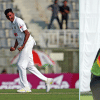Poor outfield at ZACS puts cricketers at injury risk

Bangladesh will begin their five-match Twenty20 International series against Zimbabwe today at the Zahur Ahmed Chowdhury Stadium in Chattogram on an outfield that has certainly seen better days.
Dead grass, red soil with some patches of green sprinkled across the field which only highlights the overall bareness of it, that's how the venue looked a day before the match.
The dearth of live grass on the outfield will put the fielders at risk of injuries whenever they dive to take a catch or stop the ball.
Soumya Sarkar is not part of the squad for the first three T20Is as he is still recovering from a knee injury he suffered while trying to save a boundary in the third ODI against Sri Lanka at this very ground in March.
The incident happened in the last ball of the 49th over when Soumya tripped over the boundary rope and landed on his left knee quite hard on the bare-looking surface and the subsequent injury has kept him out of action since.
Similar injuries will very much be on the cards in the three matches Bangladesh are scheduled to play at the venue, which is the last thing the Tigers would want so close to the ICC Twenty20 World Cup in June.
The country just passed the hottest April in recorded history, which has caused a severe water shortage in the region with locals living in the Kattoli area, which is adjacent to the stadium, claiming that the Chattogram WASA has been unable to ensure sufficient water supply.
The groundsmen informed that the outfield requires 4,00,000 litre of water daily but currently the ground is getting less than that in a week.
However, Chattogram WASA chief engineer Maksud Alam denied any shortage in water supply for the stadium.
"There is an express water line for the ground. We provide water through the express water line. Whenever they ask for it, we supply. They get water through the line at the scheduled time. An when they say they require more water, we provide that as well," Maksud told The Daily Star over the phone.
He, however, accepted that there is a water crisis in the area but said that the water supply at the stadium is unaffected by it.
"There is a shortage of water as in the summer the water level goes down. Still, we have prioritised it [the stadium] and have installed an express water line for it. We supply water there, even if we have to suspend supply to other places."
Bangladesh Cricket Board (BCB) ground committee manager Abdul Baten also said that the blame didn't lie squarely on WASA.
"There is nothing else WASA can do about this. Every stadium has its own deep tube well. In Chattogram, we get salt water from the deep tube well. That's the main issue. Moreover, it hasn't rained for a while. But we are working to fix it."
Many cricket grounds in the world, like the Dubai International Stadium, have a desalination plant which is used to turn sea water into fresh water which can be used to water the outfield. Installing a plant like that at the venue could be a permanent solution. However, as the stadium is under the jurisdiction of the National Sports Council, not the BCB, there is no guarantee how long it would take to solve the issue.

 For all latest news, follow The Daily Star's Google News channel.
For all latest news, follow The Daily Star's Google News channel. 








Comments